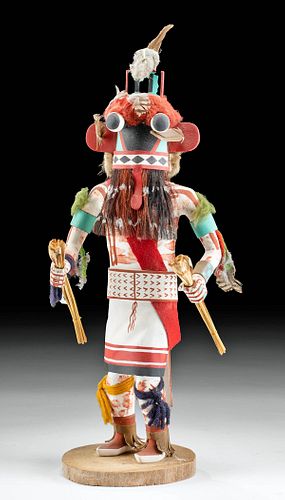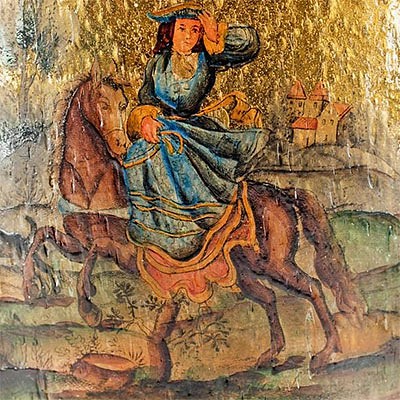Hopi Broadface Kachina Doll - Gashweseoma, 1973
Lot 61
About Seller
Artemis Fine Arts
686 S Taylor Ave, Ste 106
Louisville, CO 80027
United States
Selling antiquities, ancient and ethnographic art online since 1993, Artemis Gallery specializes in Classical Antiquities (Egyptian, Greek, Roman, Near Eastern), Asian, Pre-Columbian, African / Tribal / Oceanographic art. Our extensive inventory includes pottery, stone, metal, wood, glass and textil...Read more
Categories
Estimate:
$600 - $900
Absentee vs Live bid
Two ways to bid:
- Leave a max absentee bid and the platform will bid on your behalf up to your maximum bid during the live auction.
- Bid live during the auction and your bids will be submitted real-time to the auctioneer.
Bid Increments
| Price | Bid Increment |
|---|---|
| $0 | $25 |
| $300 | $50 |
| $1,000 | $100 |
| $2,000 | $250 |
| $5,000 | $500 |
| $10,000 | $1,000 |
| $20,000 | $2,500 |
| $50,000 | $5,000 |
| $100,000 | $10,000 |
| $200,000 | $20,000 |
About Auction
By Artemis Fine Arts
May 13, 2021
Set Reminder
2021-05-13 12:00:00
2021-05-13 12:00:00
America/New_York
Bidsquare
Bidsquare : Spring Art Auction | Fine, Folk, Fun
https://www.bidsquare.com/auctions/artemis-gallery/spring-art-auction-fine-folk-fun-6949
Featuring visual treats from around the world, and back in time to present day - fine art, folk art, and fun artsy objects. Paintings. Sculptures. Textiles. More. Convenient in-house shipping. Artemis Fine Arts info@artemisfinearts.com
Featuring visual treats from around the world, and back in time to present day - fine art, folk art, and fun artsy objects. Paintings. Sculptures. Textiles. More. Convenient in-house shipping. Artemis Fine Arts info@artemisfinearts.com
- Lot Description
Native American, Southwest, Hopi, signed by Neil Gashweseoma, ca. 1973. A hand-carved and hand-painted wooden kachina (also katsina) doll, with a label identifying the artist Neil Gashweseoma on the underside of the base. Dolls like this example depict kachina dancers who represent the supernatural katsinam beings they embody. Plaza Dances may be either Mixed Katsina Dances (Soyohim) in which dancers representing all the different types of katsinas attending, or a dance that includes only katsinas of the same type. Regardless, in addition to bringing about rain and fertility, all of the katsinas have a distinct purpose. This example is a Broadface Kachina doll presenting with characteristically bulging eyes, pronounced ears, a decorative diamond motif band over the face with an extending red tongue over his long beard, a colorful garment with a broad sash, body paint, and fringed boots. Size: 15.5" H (39.4 cm); 16.25" H (41.3 cm) on included custom stand.
In addition, he carries yucca whips in order to enforce cleaning in the community, and is highly decorated with bird feathers, a fur collar, a red fabric sash, arm cuffs, as well as yarn and feather ornaments.
The Katsinam, supernatural beings who live in the high mountains of the San Francisco Peaks above traditional Hopi territory, speak to the Hopi through costumed dance and song. These dancers emerge from the round ceremonial kivas that are at the center of their communities, singly or in groups, and dance to the music of drums, rattles, and song. Katsina figures (katsina dolls, katsin-tihu), traditionally made of cottonwood root, are made to represent these supernatural entities. Cottonwood is culturally symbolic because the cottonwood tree, once abundant in traditional Hopi lands, grows where water flows - thus, looking across a landscape, lines of cottonwood trees denote a water source in the desert. After carving, the figures are painted all over with whitewash, made from kaolin clay, and then painted in brilliant colors. Originally these were done using yucca brushes. Many of them are then decorated with other materials, like feathers, cloth, or fur. Katsina dolls are often given objects to hold which indicate their roles.
Accompanied by ribbon for special award at the "Centuries of Antiques" show at the Disneyland Hotel, Anaheim, California (August 17-19, 1973).
Provenance: private Newport Beach, California, USA collection
All items legal to buy/sell under U.S. Statute covering cultural patrimony Code 2600, CHAPTER 14, and are guaranteed to be as described or your money back.
A Certificate of Authenticity will accompany all winning bids.
We ship worldwide and handle all shipping in-house for your convenience.
#148587Kachina doll form is intact. Label with name of artist, Neil Gashweseoma, on underside of the base. Some adhesive residue on beard. Expected wear and loss to attached yarn and feather ornaments. Accompanied by ribbon for special award at the "Centuries of Antiques" show at the Disneyland Hotel, Anaheim, California (August 17-19, 1973).Condition
- Shipping Info
-
All shipping is handled in-house for your convenience. Your invoice from Artemis Gallery will include shipping calculation instructions. If in doubt, please inquire BEFORE bidding for estimated shipping costs for individual items.
-
- Buyer's Premium



 EUR
EUR CAD
CAD AUD
AUD GBP
GBP MXN
MXN HKD
HKD CNY
CNY MYR
MYR SEK
SEK SGD
SGD CHF
CHF THB
THB














